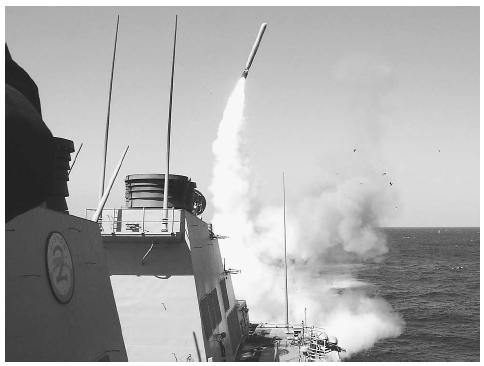Cruise Missile
Cruise missiles come in several varieties, the most well known being the Tomahawk. Operating rather like a

pilotless airplane, these missiles have powerful guidance systems that make them capable of hitting precise targets from a great distance. Operated by the United States Air Force and Navy, cruise missiles can be deployed from aircraft, submarines, and destroyers.
Of the two most notable types of cruise missile, the Tomahawk, most often used by the Navy, is 18 feet, 3 inches (5.56 m) long and weighs 2,900 pounds (1,315 kg). The Air Force AGM-86B/C weighs 3,150 pounds (1,429 kg) and measures 20 feet, 9 inches (6.3 m). The AGM, first deployed (as an 86B) in December 1982, is an air-to-ground strategic cruise missile, while the Tomahawk, which first saw service in 1986, is a long-range subsonic cruise missile for striking high-value or heavily defended land targets. Both have gone through several changes, including the introduction of the Tactical Tomahawk, to be launched from forward-deployed ships and submarines, in 2004.
A cruise missile includes a solid rocket booster, which makes up approximately fifteen percent of its weight at launch. Once it has burned its fuel, the booster falls away and the missile's wings, tail fins, and air inlet unfold. From that point until it reaches its target, the missile is powered by its turbofan engine. In flight, the cruise missile has a speed of about 550 miles per hour (880 kph).
Neither size nor speed nor rocket booster systems define the cruise missile as much as its accuracy. The Tomahawk has a range of 870 nautical miles (1,000 statute miles, or 1,609 km), and the AGM more than 1,500 miles (2,400 km) or more—the exact figure is classified—yet both are capable of hitting a target the size of a truck. Guiding these missiles are four different systems: the inertial guidance system, which detects changes in the missile's motion; terrain contour matching, which applies a three-dimensional database of the terrain over which the missile flies; global positioning system (GPS), which includes both military satellites and an onboard GPS receiver; and digital scene matching area correlation, which switches on once the missile nears its target, using an image correlator and a camera to locate the target.
█ FURTHER READING:
BOOKS:
Gormley, Dennis. Dealing with the Threat of Cruise Missiles. New York: Oxford University Press for the International Institute for Strategic Studies, 2001.
Huisken, Ronald. The Origin of the Strategic Cruise Missile. New York: Praeger Publishers, 1981.
Werrell, Kenneth P. The Evolution of the Cruise Missile. Maxwell Air Force Base, AL: Air University Press, 1985.
ELECTRONIC:
Fact Sheet: AGM-86B/C Missiles. U.S. Air Force. < http://www.af.mil/news/factsheets/AGM_86B_C_Missiles.html > (April 7, 2003).
How Cruise Missiles Work. Howstuffworks.com. < http://www.howstuffworks.com/cruise-missile.htm > (April 7,2003).
Navy Facts: Tomahawk Cruise Missile. U.S. Navy Office of Information. < http://www.chinfo.navy.mil/navpalib/factfile/missiles/wep-toma.html > (April 7, 2003).
SEE ALSO
Ballistic Missiles
Ballistic Missile Defense Organization, United States GPS
Patriot Missile System
Strategic Defense Initiative and National Missile Defense
Undersea Espionage: Nuclear vs. Fast Attack Subs
Comment about this article, ask questions, or add new information about this topic: